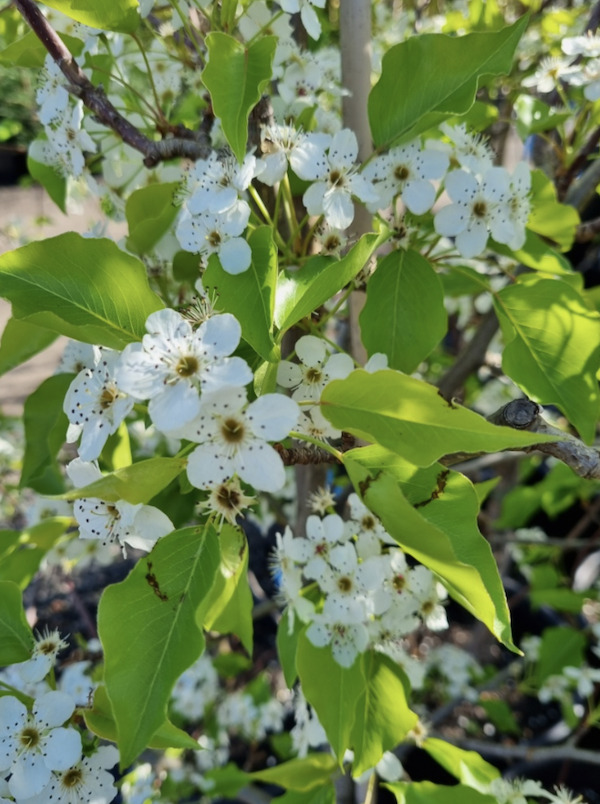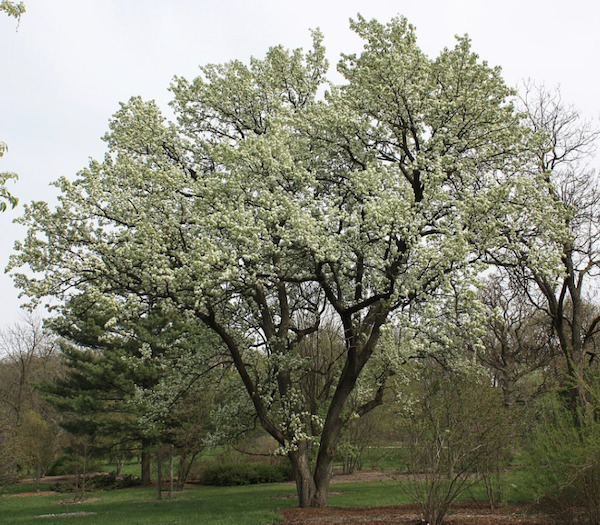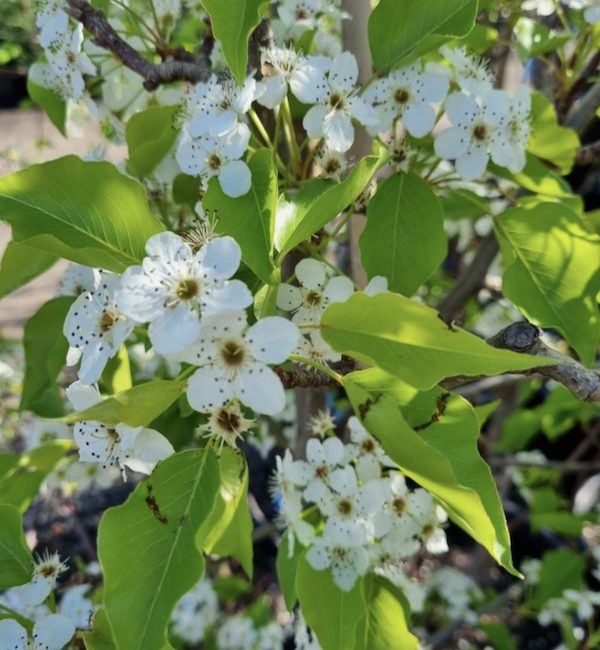This just might be the perfect tree for your Australian garden.
Ornamental Pears are drought tolerant, quick growing and flowering trees. These trees have green and glossy leaves in spring and summer, but in autumn they make a beautiful display with bright yellow, orange and red foliage that will put your garden in the coziest mood.
The Ornamental Pear’s variety throughout the seasons will provide your garden with something new to admire in each season.
Varieties of Ornamental Pears and Their Characteristics
Manchurian Pear
- Great for cold climates and can grow up to 20m tall, which may not be appropriate for a smaller suburban garden.
- It develops flower buds early in the season and blooms bright white flowers in Spring, then the leaves turn a brilliant red in Autumn
- The flowers have a light pink colour when they first bloom and the leaves have an oval shape with sharper and serrated edges.
- The Manchurian tree have a straight upright trunk with a rounded canopy of branches and leaves – this makes it a great ‘pleaching’ tree where it can be trimmed for a more hedge-like appearance.

Callery (Bradford) Pear
- This pear tree is native to China and Vietnam and can grow between 5-8m tall.
- It fruits small Callery pears with cyanide laced seeds – so it’s best to leave these pears for the birds
- The leaves of the Bradford pear are heart-shaped and in Autumn they turn brilliant yellow, red, orange and even purple
- The mature tree has an average height of 6m and a width of 6m.

Capital Pear
- This tree is one of the most popular ornamental pear trees in Australia.
- It has a narrow growth of 2-3m in width which makes it an excellent choice for creating structure and a column like break in your garden
- It’s column-like shape makes it a great tree to plant as a natural privacy architectural barrier from neighbours – plant a few of these trees in series and gain a structured and purposeful garden.
- Similar to the other Ornamental Pears, this tree flowers in late winter and early spring and then its leaves turn brilliant Autumnal colours before falling off at the end of the season
Aristocrat Pear
- This pear tree has a more pronounced and pyramidal shape with the same white flowers and deciduous features of its brothers and sister trees
- This tree grows tall (10m) and is worthy of its namesake the way it commands its environment and land.
- Its inedible yellow pomme fruits make it a messy tree for more manicured gardens and if planted in the incorrect climate it is prone to suffer diseases.
- The Aristocrat pear tree is highly tolerant of urban pollution and makes a great inner city tree that can absorb carbon and still flower beautifully in Spring.
Chanticleer Pear
- Produces dark green foliage and grows up to 7m tall
- This tree requires less maintenance and is hardier than some of its relatives – moist soil and full sun are its only term and conditions for it to thrive
- Make sure your planting spot for this tree has full sun for a minimum of 6 hours and healthy soil for the shallow roots
- The inedible brown and pea-sized fruits of this tree are great feed for the wildlife. The fruits also cling to the branches into winter and can support the birds and animals through the cold season.
Redspire Pear
- The Redspire has larger blossoms than the other Ornamental Pears and can grow up to 12m tall
- This tree requires more pruning than its relatives but is just as tolerable and adaptable as the others
- Like its relatives, the Redspire requires plenty of sun and moist soil. In these conditions it can flower and fruit in the Spring.
- The Redspire tree holds its small pea-sized fruits into the Winter and provides excellent feed for birds and other small wildlife.
- The tree’s branches form rounded canopies, it’s completely thornless and the branches never droop or dip at its edges.
Winter Glow
- This pear tree is a hardy, semi-deciduous tree that retains its leaves throughout winter (giving it its name)
- With enough sun and space, this tree can grow tall and dominate a landscape with beautiful green leaves and spring flowers
- Similar to its Capital Pear brother, the Winter glow makes a great avenue tree because of its great privacy screening foliage.
Snow Pear
- This is a wide-growing, deciduous pear tree that creates a spectacular display of flowers for weeks during early spring.
- It is frost and drought tolerant once its roots are established
- The Snow pear has greenish-yellowish fruits in Spring that have a mild sour taste and are excellent feeders for birds.
- Purple leaves arrive in the spring before the flowers and fruits, and then in Autumn the Snow Pear has spectacular deep red leaves. The Snow Pear makes a great attraction for parks or natural gardens in need of some drama.
How to treat and care for an Ornamental Pear Tree
After selecting which species of pear tree best suits your garden, it’s time to learn how to properly care for this beautiful ornamental tree.
Full sun and partial shade – it will depend on the variety of tree, but most Ornamentals prefer full sun throughout the day. And once they’re established they will provide partial shade and cover for smaller bushes and plants with their leaves.
Regular watering – While the Ornamental Pears are drought tolerant when they’re older, in the early stages of growth they need deep watering once or twice a week.
Well drained soil – After being watered, this tree needs the soil to drain properly so water and nutrients can be absorbed into its roots
Fertiliser – At the end of each season this tree type needs to restore nutrients it spent on its brilliant flowers and leaves. Fertilise the surface soil in autumn and spring to ensure healthy and nourished root systems and future foliage and flowers
Ornamental pear trees can be planted at any time of the year. Before planting, make sure their garden space has full sunlight and well draining soil.
Some varieties of the ornamental pear, such as the Capital and Chanticleer are vulnerable to wind damage, so place them somewhere in the garden that is protected from strong winds.
Are Ornamental Pear Trees Messy?
Because many of the Ornamental Pear trees fruit and bloom white flowers, they will create ‘mess’ on their garden bed. Their fruits are mostly inedible for humans but are a great attraction for wildlife meals.
If you’re worried about having to rake your garden regularly for leaves and fallen brush, this tree type might not be ideal for you.
Do Ornamental Pears Bear Fruit?
Yes, most varieties of this tree bear fruit but most often this fruit is not edible for us to eat. It’s best to leave the fruit of this tree for the local wildlife. This fruit tree has not been bred for its fruit but for its ornamental display of beautiful foliage and flowers.
If you really want to sample this fruit tree, it’s best to eat the fruits in preserves or pies. The raw fruit is not the most palatable but once cooked or preserved (specifically the Purple-leafed plums) these fruits can be tasty.
But stay away from the small brown fruits (such as the Bradford pears) because they are entirely inedible.
How tall do ornamental pear trees grow?
The Ornamentals range in height from 4m to 12m tall. The specific site of each tree will determine how tall this tree can grow. Sunlight, soil and moisture are the factors to predict how your tree will thrive.
These tall trees are excellent at creating shade without obstructing sight-lines in your landscape. And in small suburban gardens this tree with its foliage and height can contrast low lying shrubs, hedges and ground covers very well.
How to Prune Ornamental Pear Trees in Australia
- Prune in Early Spring or Autumn – it’s best to prune the tree when its young and less vulnerable to fungus or insect damage. Insects and disease will be attracted to the tree’s wounds, so take care.
- Clip away ‘Shoots’ – Pruning should begin on the bottom 3rd of the tree where shoots are sprouting. These shoots or ‘suckers’ will turn your tree into one with multiple trunks if these aren’t sheared.
- Prune horizontal branches – this step requires a bit of understanding of what you want your adult tree to look like. Do you want a pyramidal shape or more of a column structure? Prune the lateral branches from half way up the trunk, leaving about 30cm between each branch. With this spacing, each branch will be able to resist snow and ice damage as well as have a steadier framework for growth.
- Thin out dense growth – Now focus on the vertical growth of the tree, prune out dense areas to promote more air circulation through the tree’s canopy. Proper air flow will help the tree fight off fungus and bacteria from dominating the canopy – this is vital for gardens in more humid climates.
- Trim the dead or damaged areas – After you’ve pruned the young tree, it can rest until you see dead, broken, diseased or wilting branches. When these crop up, use your shears to cut close to the trunk (about 2cm of the branch should remain). Don’t cut the entire branch flush to the trunk, leave a small stump so the bark of the tree is undamaged. If you prune to close to the trunk, you will make your tree vulnerable without a layer of bark to protect itself from the elements as well as insects, disease and pests.
- Proper disposal and care of tools – Once you’ve cut and pruned the tree it’s time to dispose of the branches, twigs and leaves. While you could just cuts up the branches and bag all the waste, you could also use this natural material for sustainable composting. Remember to also sterilise your tools in boiling water (to prevent spreading of bacteria and fungus). Leave your blades, shears and scissors in water for 30 seconds to 1 minute.

